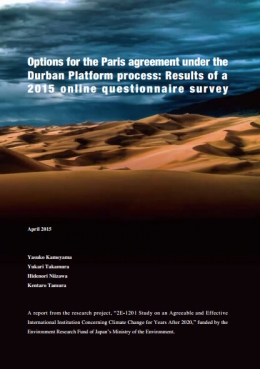Options for the Paris agreement under the Durban Platform process: Results of a 2015 online questionnaire survey
The 17th Conference of the Parties (COP17) to the United Nations Framework Convention on Climate Change (UNFCCC) held in Durban, South Africa, in November–December 2011 reached a decision known as the Durban Platform. It launched “a new process to develop a protocol, another legal instrument or an agreed outcome with legal force under the UNFCCC,” which would be “applicable to all Parties.” The process was to be completed as early as possible, but no later than 2015, so that the new instrument could come into effect and be implemented by 2020.
This report covers the results of the third survey conducted in January 2015. The 20th Conference of the Parties (COP20) was held in Lima, Peru in late 2014, and the “Lima Call for Climate Action” had been agreed upon by the time of the survey. The questionnaire survey selected some contentious article options in the document; it asked the respondents to choose one article option from among several and decide in which instrument (i.e. a protocol, an annex to a protocol, a COP decision at COP21, or a COP decision in a future COP) the chosen article should be inserted. Nineteen respondents answered the questionnaire survey. Their responses were categorized into two distinct agreement options for the Paris conference in late 2015.
Group 1: Finalizing NDCs at COP21
Respondents categorized in this group expect a negotiating process whereby the intended nationally determined contributions (INDCs) submitted by the Parties are to be finalized at COP21. A list of NDCs will be attached as an annex to a core legal agreement. By doing so, the NDCs will be treated as legally binding targets inserted in a legal document. Also, by finalizing the NDCs by 2015, countries will be able to start internal legislation processes to ratify the agreement as soon as possible, so that the agreement can enter into force before 2020. Although negotiators may consider amendments in annexes to protocols to be time consuming and troublesome, the amendment procedure could be simplified so that countries can occasionally update their NDCs.
This option allows no opportunity for negotiators and non-state actors to conduct ex-ante assessments to evaluate the adequacy of the levels of INDCs submitted by the Parties before finalization. This means there is a substantial chance that the total of the NDCs from all countries will exceed the emission level required to attain the long-term 2-°C target. If the original global target for the post-2020 period—such as through 2025—is considered to be loose, then a COP decision could then be agreed on to revisit each country’s NDC in 2018 and possibly determine more ambitious NDC levels for the year 2030. In terms of financial commitment, by 2018 the Standing Committee of Finance supervising the Green Climate Fund will review developed countries’ and other countries’ activities related to mobilization of finance and report to the COP. The timing of determination of the aggregate financial target for the post-2020 period is consistent with the timing of the determination of the next round of NDCs, so that the developing countries’ NDCs can be set according to funding availability. The COP will determine a goal for the aggregate amount of financial mobilization for the post-2020 period.
Group 2: Finalizing NDCs at COP22 or 23
This group expected a simple and concise core agreement that inscribes only the general nature of the NDCs without indicating specific NDCs in the document. A COP decision will be agreed on at COP21 to conduct an ex-ante consultation process in 2016, requesting each Party to reconsider its INDC if necessary and finalizing the NDCs at COP22 or COP23 by agreeing on a COP decision including a list of finalized NDCs for all countries. In this way, negotiators and non-state actors will be given an opportunity to discuss the adequacy of countries’ INDCs, and countries will have enough time to revisit their INDCs before finalization. This is thought to be an important process if the total amount of initial INDCs exceeds the global emission level required to reach the long-term target of 2°C.
Delay in finalization of NDCs is a serious drawback of this option, because such a delay will delay the implementation of legislation in each country and delay the enforcement of the Paris agreement, which is expected to enter into force before 2020. Furthermore, delay of finalization does not necessarily mean that the level of the NDCs will be greater than that of the initial INDCs. Under this option a comprehensive monitoring, reporting, and verification (MRV) process would thus be prepared to partially overcome these shortcomings. A new governing body for MRV would be established to regularly monitor, receive reports on, and verify the progress of the Parties’ actions related to climate mitigation, adaptation, and effective use and mobilization of means of implementation.
The developed countries and other countries will be expected to submit their financial targets for the years beyond 2020 by 2017. Fast-start financing for the post-2020 period will be designed to complement the NDC finalization delay.

